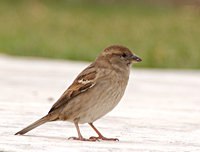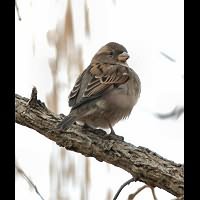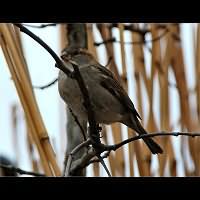[All pictures of garden wildlife on this page are thumbnails. Click on any thumbnail for a large format to be displayed.]
House Sparrow (Passer domesticus)
Click![]() here for the bird's sound.
here for the bird's sound.
The House Sparrow: a female to the left and a male to the right.
This is perhaps the best known European bird. For many centuries it has accompanied man. Until recently it was considered to be the most common bird in Holland counting about 3.5 million species in 1980. Over the past few decennia, due to modern building construction methods aimed at improved insulation the numbers of House Sparrows declined dramatically. The estimations of 1997 indicated that some 2.5 million species occupy my country, making it only the second most common bird (after the Blackbird). Wherever you find people, you find the House Sparrow. The bird is very similar to the Tree Sparrow and the Dunnock, but there are striking differences. The House Sparrow male has a very distinctive gray cap. The animal prefers larger cities and villages and is not present in rural areas, where you will find it's close relative the Tree Sparrow. Although the Dunnock is also called the Hedge Sparrow it's not even a member of the same family and has a more fragile beak. The House Sparrow is very socially oriented bird. When appearing in your garden you find that there's never just one of them. Sometimes it even looks like an invasion! Add to this that they are constantly arguing over food, water and even sand (the creature not only bathes in water, but in sand as well) and you can guess that they bring a lively atmosphere in your garden. They eat almost everything: insects, all kinds of seeds and left overs of human diners. In the last century they were introduced in the United States where they quickly spread and became very succesful, but competing with some native birds making them less numerous. The introduction of foreign animals in a new environment always seems to raise problems, similar to the huge problem after introduction of the rabbit in Australia.
Being social birds House Sparrows communicate a lot by twittering and chittering.
This bird belongs to the family of Sparrows (Passeridae). It is an infrequent visitor to my garden and can be seen in Holland all year round. The bird is 6" and weighs 30 grams. It lives in cities and villages mostly. It eats almost everything. Compared to the male, the female is greyish brown and almost without contrast en lacks the grey cap. House Sparrows make a nest from april to june. Normally they build it in roofs or holes in houses. Rarely the bird makes a relatively huge and complicated nest in a tree. Four to six eggs are laid two times a year. The breeding period is a fourtnight, the young remain inside the nest for about 15 days.
| Name of this bird in various other languages | ||||
| Dutch | German | French | Polish | Scientific |
| Huismus | Haussperling | Moineau domestique | Wróbel | Passer domesticus |

© Copyright 1998-2024 gardensafari.net (Hania Berdys)

 English / engels
English / engels  Dutch / nederlands
Dutch / nederlands




